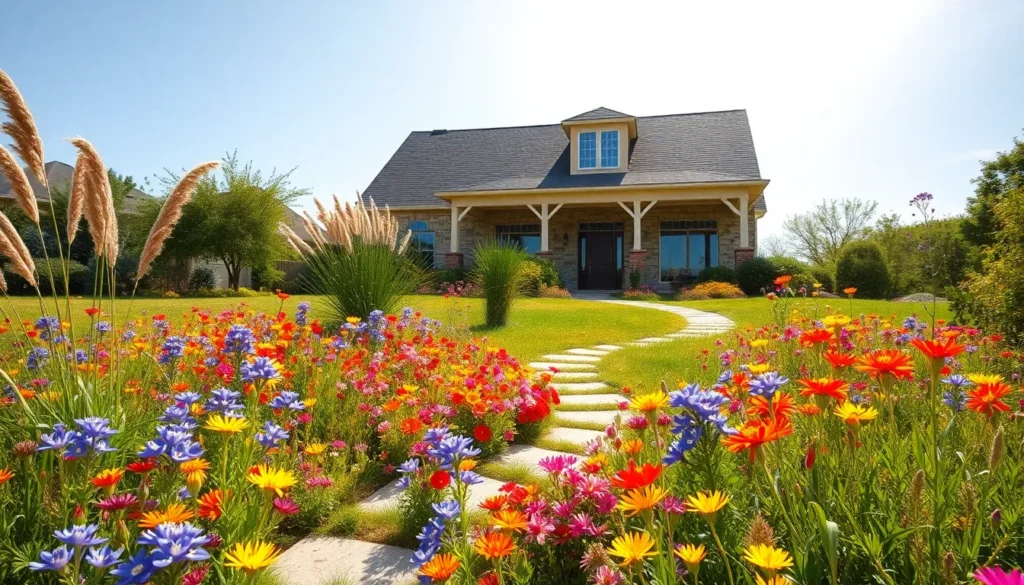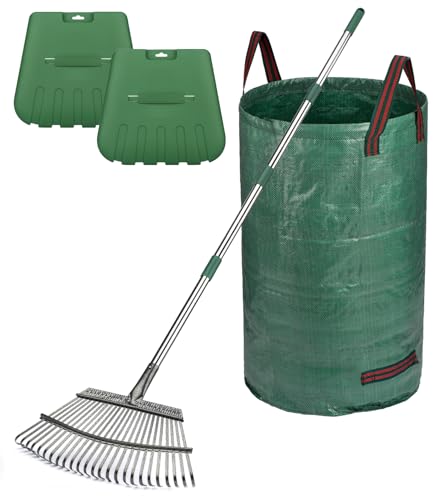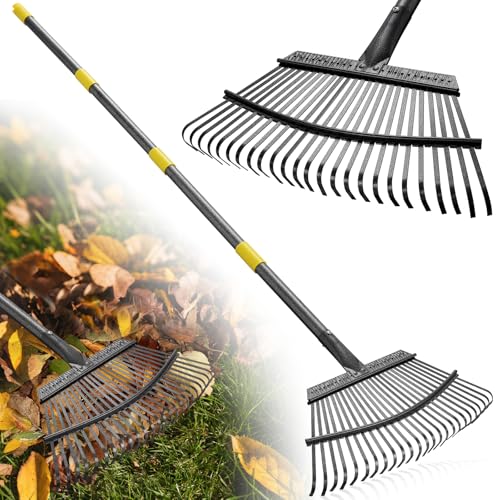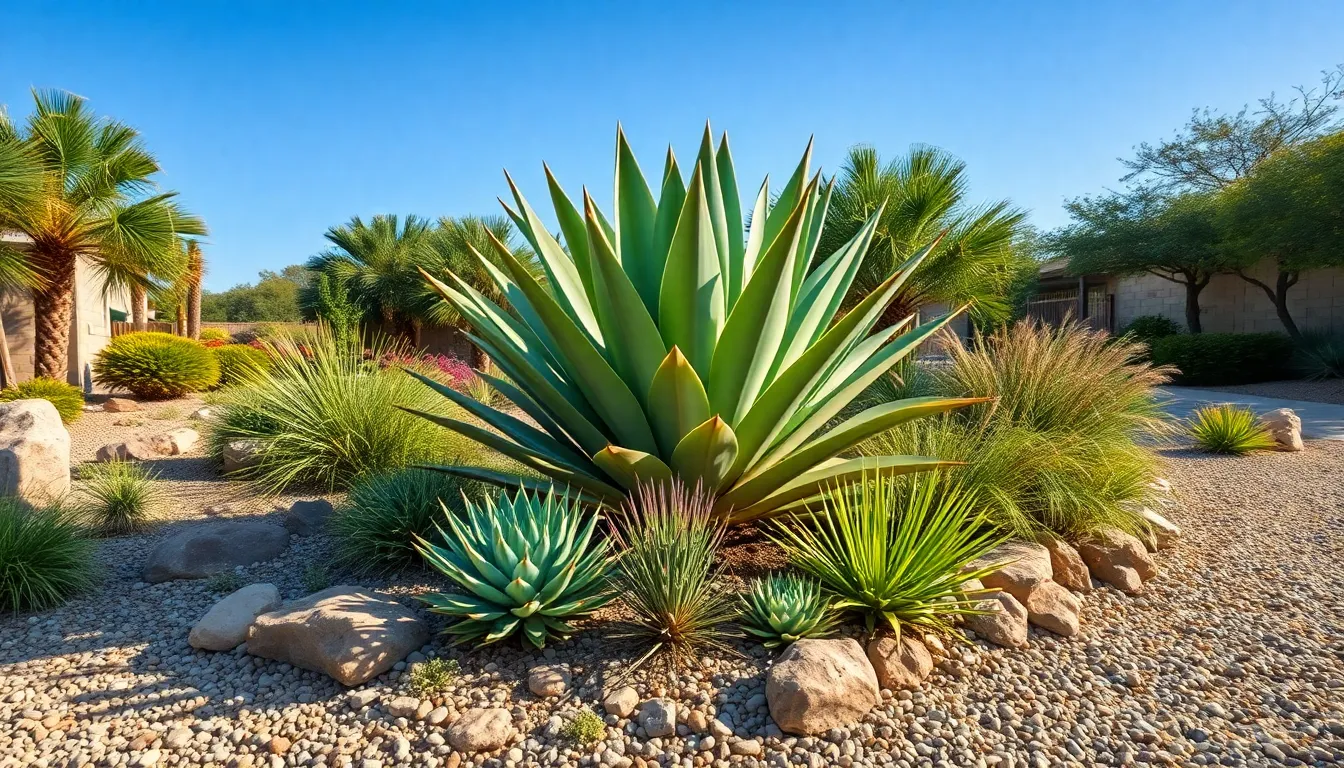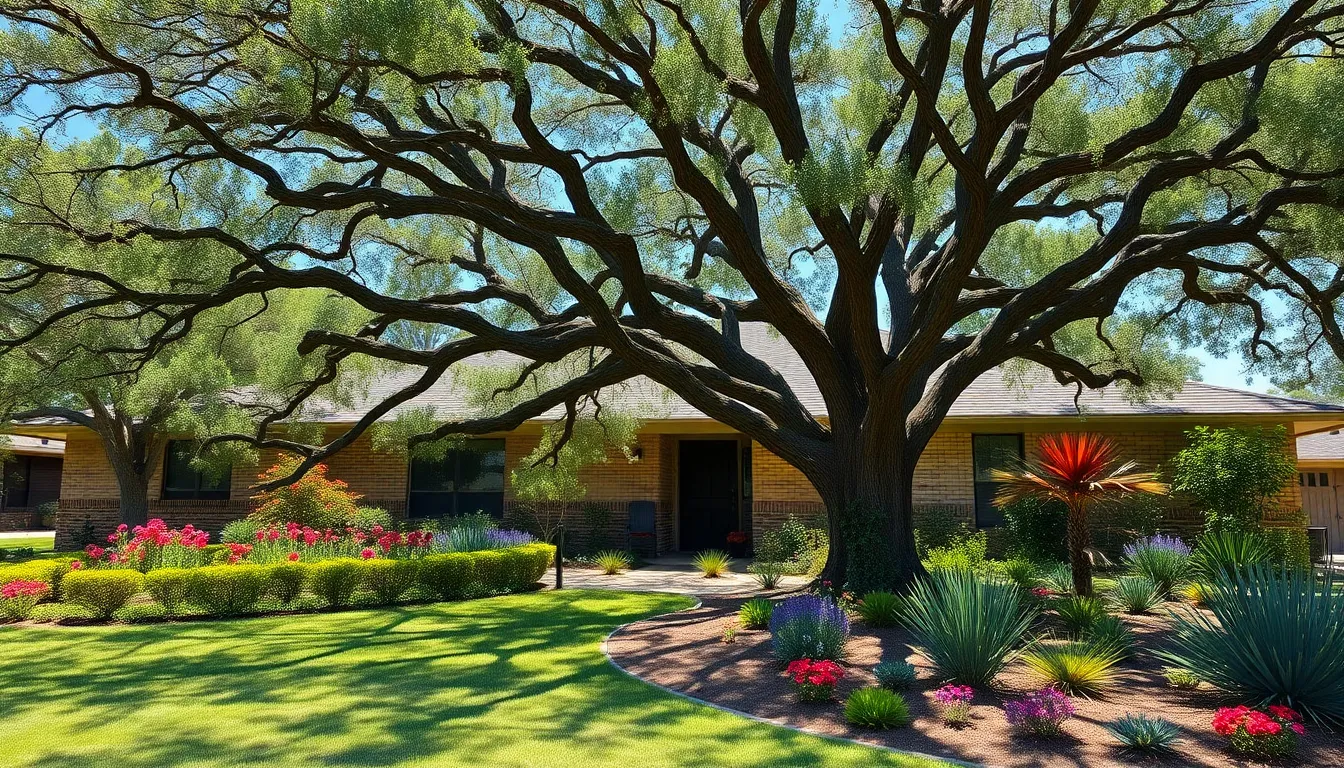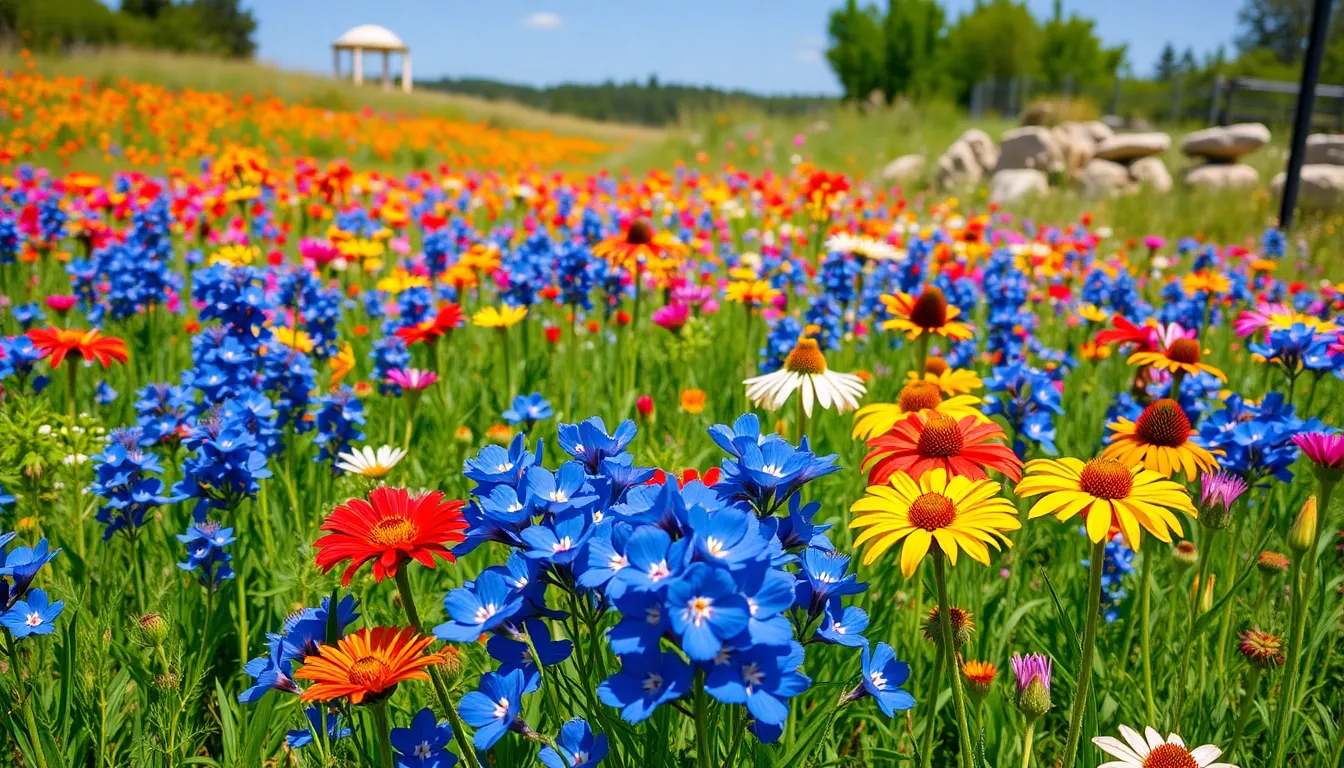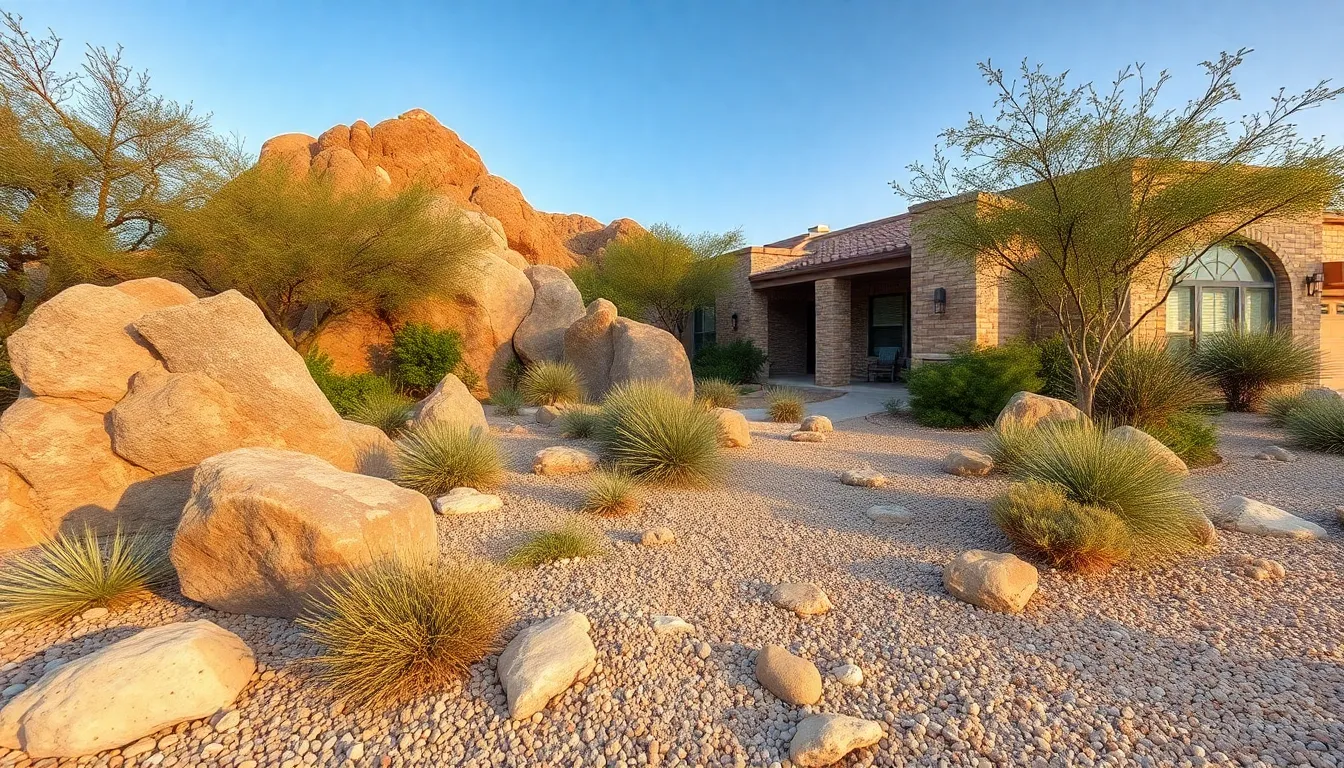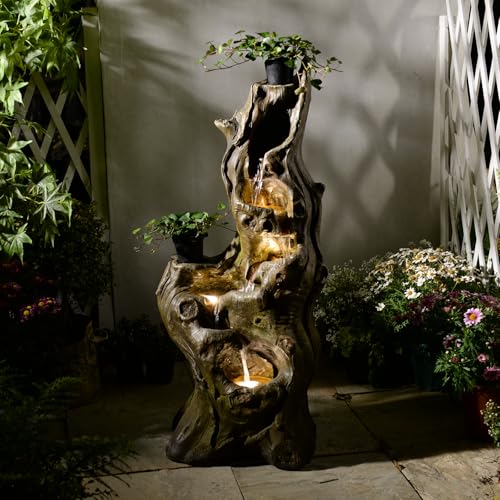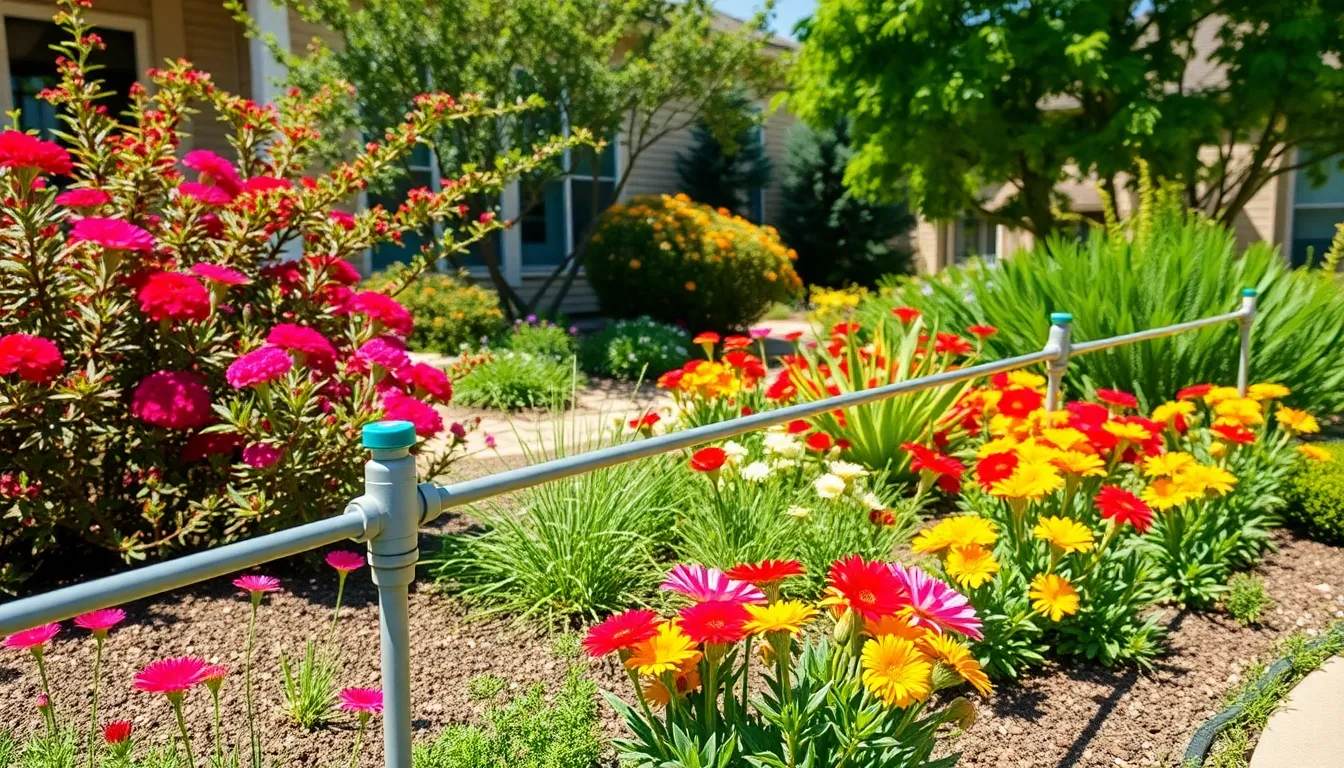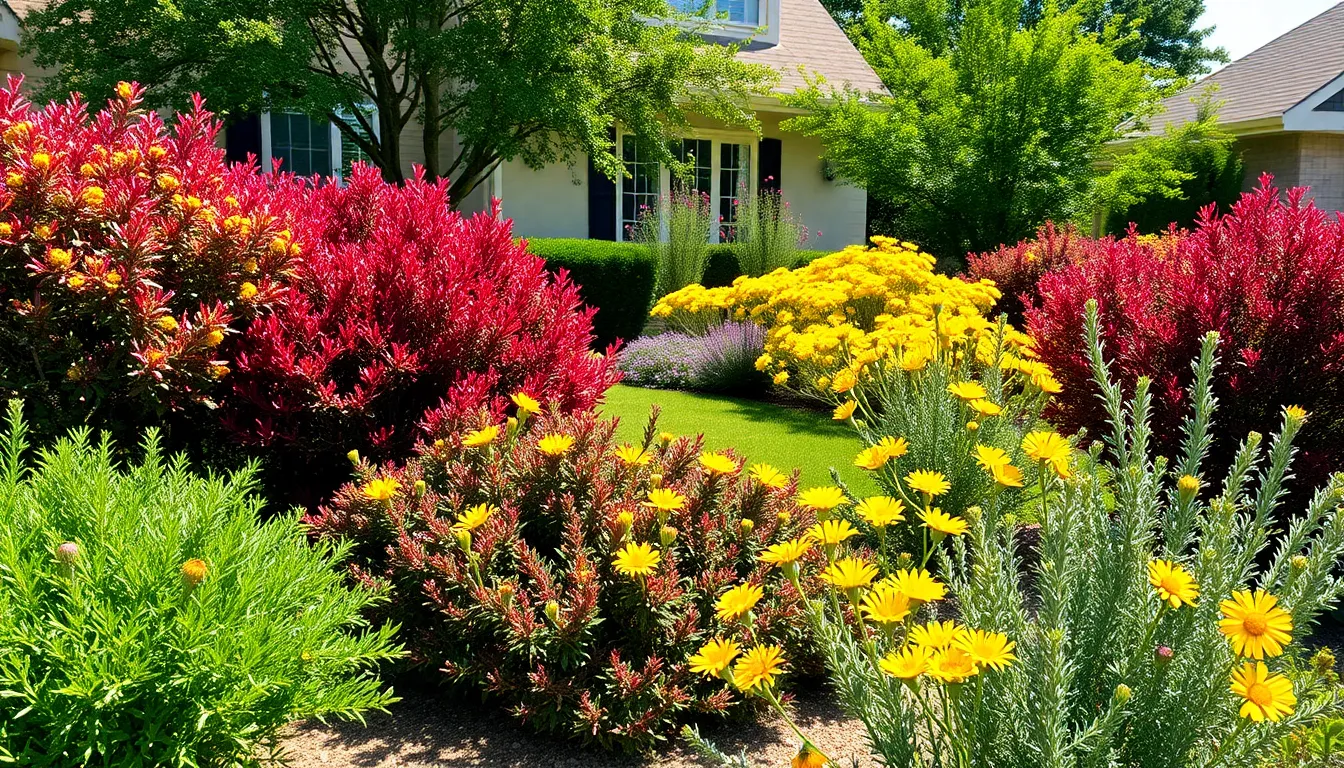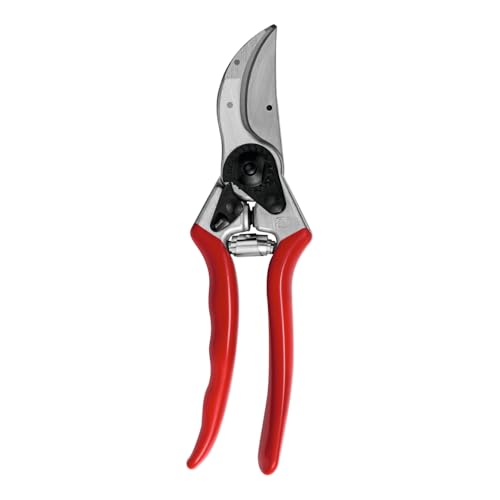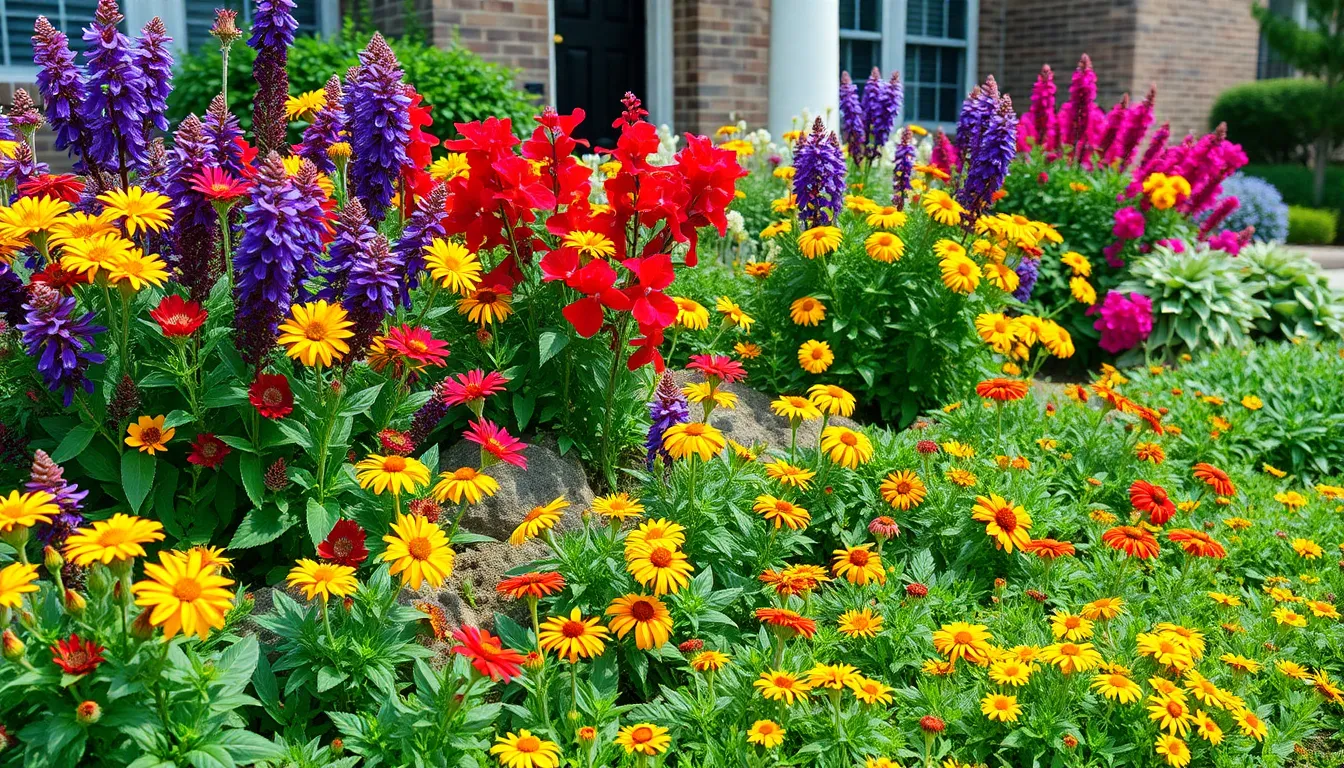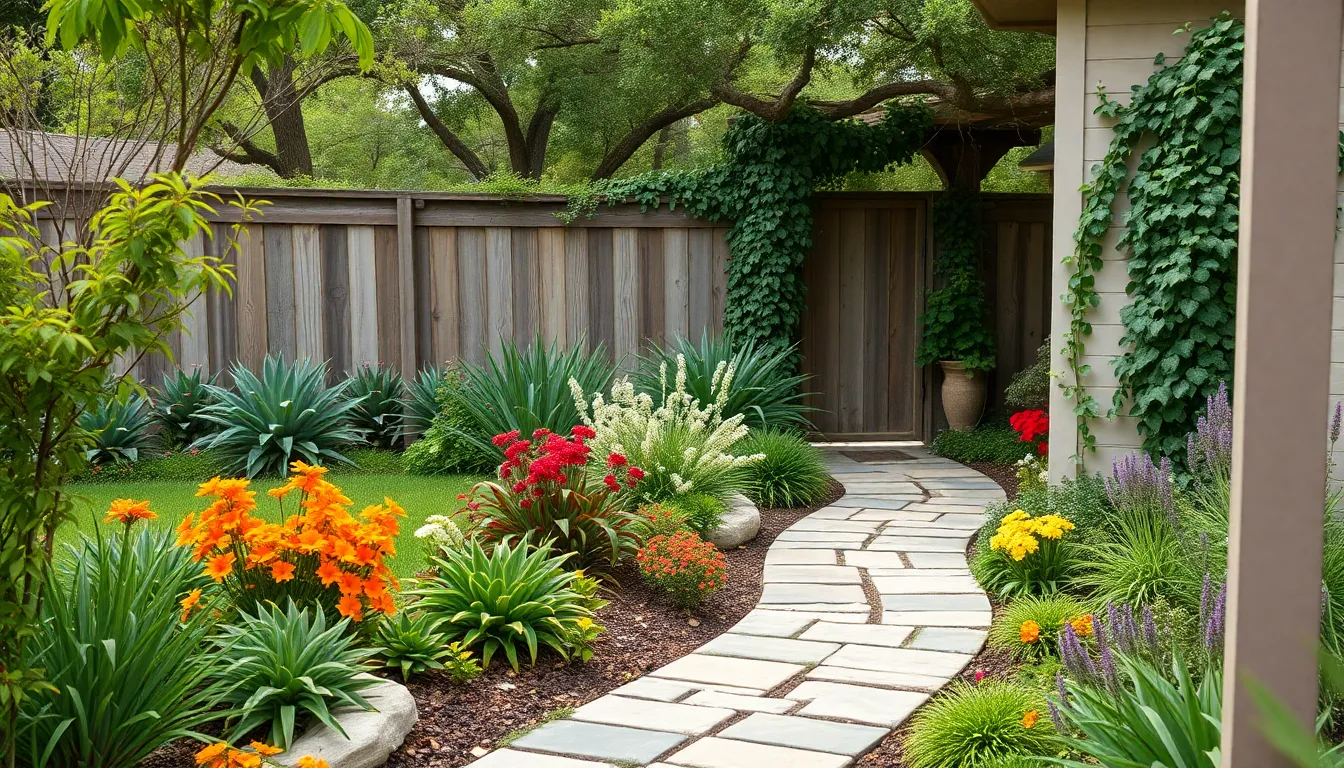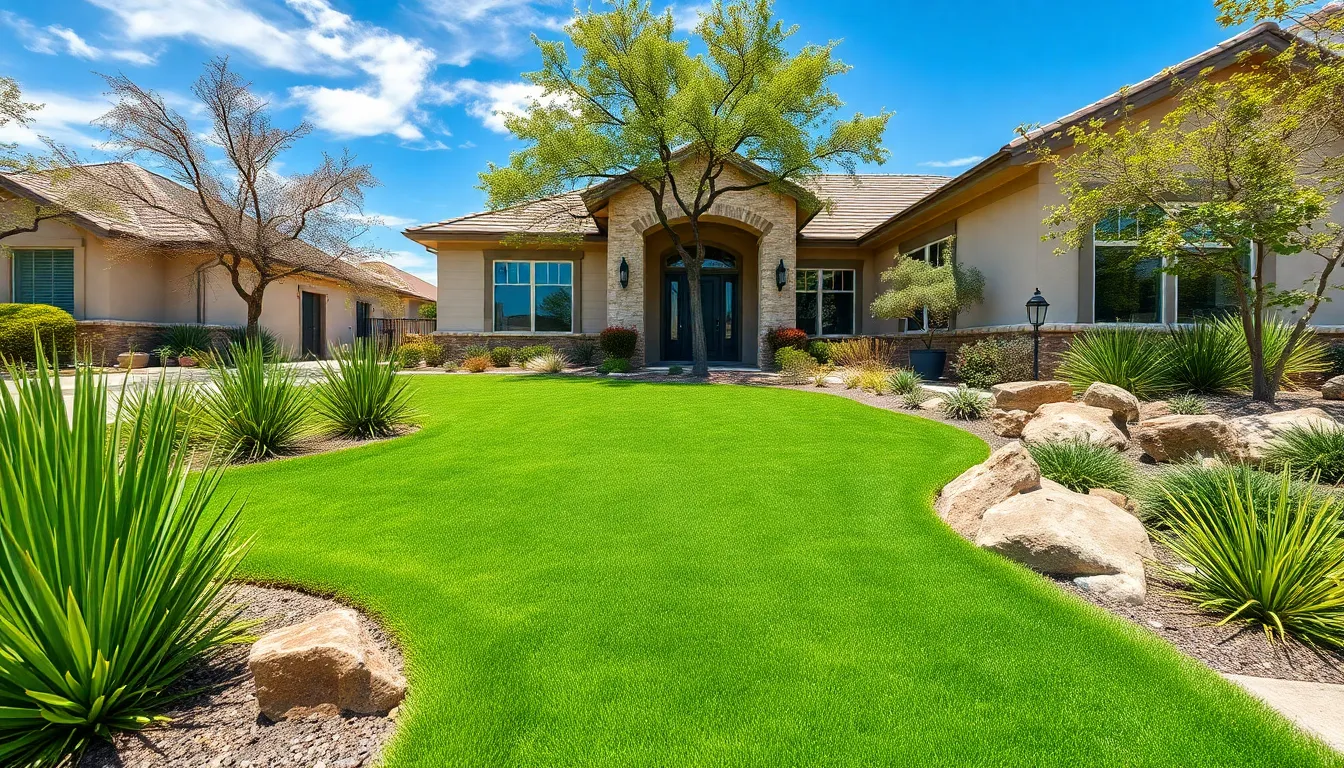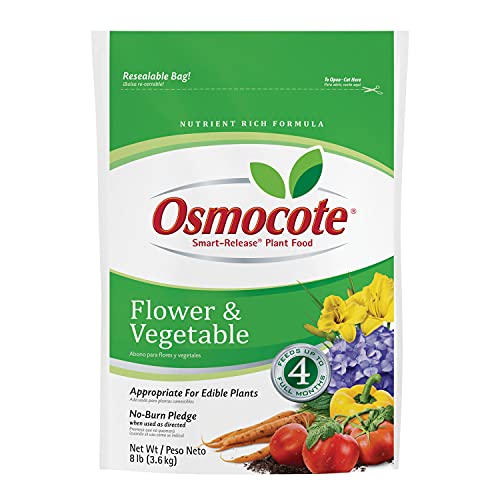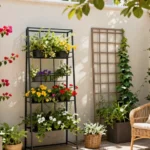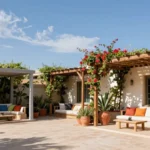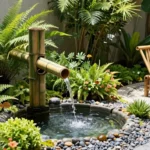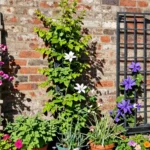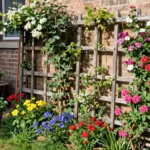We know that creating a stunning front yard in Texas comes with unique challenges. The intense heat drought conditions and unpredictable weather patterns can make traditional landscaping feel impossible. But here’s the thing – your Texas home can have the most beautiful front yard on the block with the right approach.
Texas-friendly landscaping isn’t just about survival – it’s about creating an outdoor space that thrives in our climate while boosting your home’s curb appeal and property value. We’ve discovered that working with Texas rather than against it opens up incredible possibilities for vibrant drought-resistant gardens that stay gorgeous year-round.
From native wildflower meadows to modern succulent displays we’ll share the landscaping ideas that transform ordinary Texas front yards into neighborhood showstoppers. These aren’t just pretty concepts – they’re practical answers that save water reduce maintenance and create outdoor spaces you’ll actually want to spend time in.
Drought-Resistant Native Plant Gardens
Native Texas plants offer the perfect solution for creating stunning front yards that thrive without excessive watering. We’ve discovered that these hardy plants not only survive our challenging climate but actually flourish in conditions that would stress traditional landscaping choices.
Texas Bluebonnet Displays
Bluebonnets create spectacular spring displays that transform ordinary front yards into breathtaking wildflower showcases. We recommend planting these state flowers in dense clusters of 50 to 100 plants per 10 square feet for maximum visual impact. Sowing seeds in fall allows bluebonnets to establish strong root systems before their March through May blooming period.
Mixed wildflower combinations work exceptionally well when we pair bluebonnets with Indian paintbrush, pink evening primrose, and white poppies. These companions bloom simultaneously and create stunning color contrasts that catch every neighbor’s attention. Seeds germinate best when scattered on disturbed soil and lightly raked in October or November.
Maintenance requirements remain minimal once bluebonnets establish themselves in your Texas front yard. We simply allow the plants to complete their natural cycle by going to seed before mowing in late spring. This self seeding process ensures beautiful displays return year after year without replanting.
Prickly Pear Cactus Arrangements
Prickly pear cacti provide year round structure and dramatic architectural elements that define modern Texas landscaping. We position these sculptural plants as focal points near entryways or property corners where their bold forms create striking visual anchors. Different varieties like Opuntia engelmannii and Opuntia macrocentra offer varying sizes from 2 feet to 6 feet tall.
Seasonal interest peaks during spring when bright yellow, orange, or pink blooms crown each paddle shaped segment. We’ve found that these showy flowers attract native pollinators including bees, butterflies, and hummingbirds to our front yards. Purple or red fruits follow the blooms and provide food sources for local wildlife throughout summer months.
Companion plantings enhance prickly pear arrangements when we add desert willow, cenizo, and yucca plants around the base. These drought tolerant partners create layered textures while maintaining the xeriscape aesthetic. Decomposed granite or river rock mulch completes the desert garden look and suppresses weeds effectively.
Native Grass Combinations
Buffalo grass establishes the foundation for low maintenance Texas front yards that stay green with minimal irrigation. We plant this native species in spring when soil temperatures reach 80°F for optimal germination rates. Buffalo grass requires only 1 inch of water monthly during establishment and even less once mature.
Ornamental grass accents add movement and texture when we incorporate little bluestem, Gulf muhly, and inland sea oats throughout the industry. These perennial grasses reach heights between 2 and 4 feet and provide stunning fall color displays. Seedheads persist through winter months offering continued visual interest and bird habitat.
Maintenance schedules involve cutting back ornamental grasses once annually in late winter before new growth begins. We mow buffalo grass areas 3 to 4 times during growing season to maintain a neat appearance. Overseeding may be necessary in high traffic areas every 2 to 3 years to maintain density.
Xeriscaping With Succulent Features
We’ve found that xeriscaping transforms Texas front yards into stunning water efficient landscapes that thrive even though our state’s challenging climate conditions.
Agave Centerpiece Designs
Agave plants create bold architectural focal points that instantly elevate your front yard’s visual appeal. We recommend positioning species like Agave americana or Agave parryi centrally or near entryways where their dramatic forms command attention. These drought tolerant specimens require minimal irrigation while offering pest resistant durability that stands up to Texas heat.
Surrounding your agave centerpiece with complementary plants enhances the overall design impact. We suggest pairing them with smaller succulents, ornamental grasses, or decorative rock mulch to create cohesive native inspired aesthetics. The contrast between the agave’s bold structure and softer surrounding elements adds visual depth while maintaining water conservation principles.
Rock Garden Integration
Rock gardens provide excellent water wise landscaping answers that blend naturally with Texas’s rugged terrain. We use native river rocks or limestone to create drainage friendly environments around succulents and drought tolerant shrubs. These materials help prevent soil erosion, suppress weeds, and reduce maintenance requirements significantly.
Strategic rock placement around your succulent displays creates organic looking landscapes that fit our local environment seamlessly. We arrange rocks of varying sizes to establish visual interest while ensuring proper drainage for your plants. The combination of textured stones with colorful succulents produces stunning contrasts that enhance curb appeal year round.
Gravel Pathway Systems
Gravel pathways offer functional walkways that complement xeriscape front yards beautifully. We choose native stone or color coordinated gravel that retains heat and allows excellent drainage, preventing water pooling issues common in Texas climates. These pathways require minimal upkeep while providing attractive connections between different yard features.
Meandering gravel paths through your succulent beds create inviting routes that guide visitors through your industry design. We design these walkways to connect rock gardens, agave centerpieces, and other drought tolerant features harmoniously. The pathways enhance both functionality and visual flow while maintaining the water efficient principles essential for successful Texas landscaping.
Shade Tree Canopy Solutions
Creating effective shade in your Texas front yard requires selecting large, drought-tolerant native trees that develop wide canopies. We recommend utilizing a layered canopy approach that combines taller trees with understory shrubs to maximize shade coverage and create comfortable microclimates.
Live Oak Placement Strategies
Position live oaks strategically to block harsh afternoon sun and reduce cooling costs by placing them to the south or west of your house. These iconic Texas trees (Quercus virginiana) feature broad, evergreen canopies that provide year-round shade and exceptional drought resilience.
Allow sufficient space for their expansive root systems and wide branches, which typically spread 40 to 60 feet in diameter. We suggest ensuring they don’t interfere with structures or power lines by planning their mature size during the planting phase.
Group live oaks with complementary drought-tolerant plants to create naturalistic, low-maintenance settings. Consider pairing them with native Texas sage or cenizo for a cohesive industry design that thrives in our climate.
Texas Red Oak Selections
Choose Texas red oaks (Quercus buckleyi) for stunning seasonal color changes with brilliant red foliage in fall that adds visual interest to your front yard. These native trees prefer partial shade and well-drained soils while adapting exceptionally well to Texas climate conditions.
Place them near entryways or pathways to maximize their seasonal color impact and create welcoming entrance areas. We recommend positioning them where their autumn display can be appreciated from both inside your home and the street.
Mix Texas red oaks with evergreen trees like live oaks to balance year-round greenery with vibrant autumn tones. For small to medium-sized front yards, we suggest selecting dwarf or layered red oak varieties to avoid overcrowding your industry.
Mesquite Tree Arrangements
Space mesquite trees widely to accommodate their irregular, spreading root and branch systems that characterize these hardy, drought-tolerant natives. These trees (Prosopis spp.) excel at creating informal shade areas while requiring minimal water once established.
Combine mesquites with native grasses and succulents to reflect the natural Texas industry and conserve water effectively. We suggest using varieties like buffalo grass or Mexican feather grass to complement their informal growth patterns.
Use mesquite trees as focal points in xeriscape or desert-style front yards by complementing them with rock gardens and mulched beds for low maintenance appeal. Their unique branching structure creates interesting silhouettes that enhance the architectural character of your industry design.
Colorful Wildflower Meadow Designs
We can transform our Texas front yards into stunning displays of natural beauty with wildflower meadows that showcase the state’s native flora. These vibrant landscapes create eye-catching curb appeal while supporting local ecosystems and pollinators.
Seasonal Bloom Scheduling
Planning our wildflower displays around seasonal bloom times ensures continuous color throughout the year. Fall planting works best for Texas wildflowers since many species are cool-weather plants that germinate when temperatures drop below 70°F. This timing allows plants to develop strong root systems over winter and bloom prolifically in spring.
Scheduling early spring bloomers like bluebonnets and Indian paintbrush creates spectacular displays from March through May. Mid-season flowers such as heartleaf skullcap and coneflowers extend the show into summer months. Late-blooming varieties like Texas lantana and rudbeckia provide colorful displays through late fall, ensuring our meadows remain vibrant across multiple seasons.
Mixed Wildflower Seed Combinations
Combining different wildflower species creates diverse, resilient meadows that offer varied colors and textures. Mixing bluebonnets with Indian paintbrush provides the classic Texas combination of blue and red-orange blooms. Adding bee balm, gaillardia, and Engelmann daisy creates a broader spectrum of colors throughout the growing season.
Strategic combinations like black-eyed Susan, winecup, and Texas greeneyes offer varied bloom times and heights for visual interest. Including skeleton-leaf goldeneye daisy and mealy blue sage adds texture diversity while supporting different pollinators. These mixed plantings create more stable ecosystems that naturally resist pests and diseases better than single-species displays.
Maintenance-Free Growing Zones
Establishing wildflower meadows in maintenance-free zones requires minimal ongoing care once plants become established. Well-drained soil and at least six hours of sunlight create ideal growing conditions for most Texas wildflowers. Bordering beds with native rocks or limestone blocks gives a polished look while controlling grass encroachment.
Using cardboard mulching techniques suppresses grass growth without chemicals, creating clean growing zones for wildflowers. These native plantings naturally resist local pests and drought conditions, requiring significantly less water than traditional lawns. Once established, our wildflower meadows need only occasional weeding and annual reseeding to maintain their vibrant displays year after year.
Desert Landscape Rock Gardens
Desert industry rock gardens offer the perfect solution for Texas front yards that need to withstand intense heat while maintaining stunning visual appeal. These low-maintenance landscapes combine drought-tolerant native plants with strategic stone placement to create water-efficient designs that thrive in our challenging climate.
Limestone Boulder Placement
Limestone boulders transform ordinary front yards into dramatic focal points that mirror Texas’s natural terrain. We recommend positioning these substantial stones to simulate the rock outcroppings commonly found throughout our state, creating authentic landscapes that feel indigenous to the region. Strategic placement near entryways establishes commanding visual anchors that draw the eye and define distinct garden zones.
Boulder groupings work best when arranged in odd numbers of three or five pieces. Position the largest boulder first as your primary focal point, then arrange smaller stones around it to create natural-looking clusters. This technique mimics how limestone formations occur in nature across Texas hill country and desert regions.
Functional benefits extend beyond aesthetics when you incorporate limestone boulders into sloped areas. These substantial stones provide excellent erosion control while serving as informal seating areas or natural borders for planting beds. Their thermal mass also helps moderate soil temperatures around nearby plants during extreme heat periods.
Decomposed Granite Pathways
Decomposed granite pathways deliver both durability and visual appeal for Texas front yard designs. This permeable material allows rainwater to penetrate the surface, preventing runoff issues while maintaining excellent drainage during our intense thunderstorms. DG’s warm earth tones blend seamlessly with limestone boulders and native desert plants.
Installation requires minimal maintenance once properly compacted and edged. We suggest creating pathways between 36 to 48 inches wide to accommodate comfortable walking while defining clear traffic patterns through your rock garden. The material’s natural compaction prevents weeds from establishing while maintaining a soft, organic appearance.
Color variations in decomposed granite allow for creative design flexibility. Choose from natural buff, reddish-brown, or gray tones to complement your existing stone elements and plant selections. The rustic charm of DG pathways enhances desert-style landscapes while providing stable surfaces that won’t shift or scatter like loose gravel.
Accent Stone Arrangements
Accent stones add crucial detail and contrast to larger industry elements throughout your desert rock garden. River rocks, polished stones, and smaller limestone pieces create visual breaks around plant groupings and pathway edges. These carefully selected stones highlight focal points while preventing monotonous expanses of mulch or bare soil.
Layering different stone sizes creates depth and natural flow within your design. Place larger accent stones first to establish primary visual anchors, then fill surrounding areas with medium-sized rocks and smaller pebbles. This graduated approach mirrors how natural stone deposits form in Texas creek beds and desert washes.
Strategic placement around water features or specimen plants amplifies their visual impact. Use light-colored stones to reflect heat away from sensitive plants while darker accents can absorb warmth for cold-hardy species. Group accent stones in organic patterns that avoid rigid geometric arrangements, maintaining the naturalistic feel essential to successful desert landscaping.
Water-Wise Irrigation Systems
We can maximize water efficiency in our Texas front yards by implementing strategic irrigation systems that work with the climate instead of against it. These systems reduce water consumption while maintaining beautiful landscapes that thrive in drought conditions.
Drip Irrigation Installation
Drip irrigation delivers water directly to plant roots, making it the most efficient watering method for Texas landscapes. This system reduces evaporation by up to 50% compared to traditional sprinklers, ensuring water reaches exactly where plants need it most. We recommend installing drip irrigation for trees, shrubs, and flower beds since these areas benefit from consistent, deep watering.
The installation process involves laying flexible tubing with small emitters that release water slowly over time. This method prevents runoff and allows soil to absorb water gradually, promoting healthier root systems. Cost effectiveness makes drip irrigation particularly attractive, as it typically reduces water bills by 30-50% while requiring minimal maintenance once installed.
Smart Sprinkler Technology
Smart sprinkler systems use sensors and weather data to automatically adjust watering schedules based on real time conditions. These systems prevent overwatering by monitoring soil moisture levels and local weather forecasts, adapting to seasonal changes without manual intervention. We’ve seen homeowners reduce their water usage by 20-30% simply by upgrading to smart technology.
Advanced features include smartphone connectivity that allows remote monitoring and control of irrigation zones. Rain sensors automatically pause watering cycles during storms, while soil moisture sensors ensure plants receive water only when needed. This technology enhances water savings while keeping landscapes healthy throughout Texas’s unpredictable weather patterns.
Rainwater Collection Integration
Rainwater harvesting systems capture and store precipitation for later use in irrigation, reducing dependence on municipal water supplies. Installing barrels or cisterns allows us to collect substantial amounts of water during Texas’s sporadic but often intense rainfall events. A single inch of rain on a 1,000 square foot roof can yield approximately 600 gallons of harvestable water.
Collection systems range from simple barrel setups costing under $200 to sophisticated cistern installations that store thousands of gallons. We recommend positioning collection points strategically around the property to maximize capture efficiency while ensuring easy access for irrigation use. This method supports sustainable landscaping practices by utilizing natural precipitation that would otherwise flow into storm drains.
Texas-Friendly Shrub Borders
Strategic shrub borders transform Texas front yards into structured landscapes that withstand intense heat while providing year-round visual appeal. These carefully chosen plantings create natural boundaries and add texture without requiring excessive water or maintenance.
Barberry Hedge Designs
Barberry shrubs excel at forming dense privacy hedges that thrive in Texas’s challenging climate conditions. Their colorful foliage ranges from deep red to golden yellow, creating striking contrast against green lawns and neutral hardscaping elements. Thorny branches provide natural security while requiring minimal pruning throughout the growing season.
Dense growth patterns make barberry hedges ideal for property line borders or front yard foundation plantings. We recommend spacing plants 2-3 feet apart to achieve full coverage within two growing seasons. Tolerance for various soil types means these hedges adapt well to clay-heavy ground or sandy conditions common across Texas regions.
Formal garden designs benefit from barberry’s structured appearance when trimmed into geometric shapes. Informal landscapes showcase the plant’s natural arching form, which complements wildflower meadows and native grass plantings perfectly.
Esperanza Flowering Displays
Esperanza delivers vibrant yellow trumpet blooms from spring through fall, earning its reputation as Texas yellow bells. Full sun exposure and well-drained soil conditions trigger abundant flowering that attracts hummingbirds and butterflies to front yard spaces. Heat tolerance makes this shrub exceptional for south-facing borders where other flowering plants struggle.
Clustered plantings create dramatic focal points near entryways or mailbox areas where curb appeal matters most. We suggest grouping 3-5 esperanza shrubs together for maximum visual impact and pollinator attraction. Mature height reaches 4-6 feet, making these displays perfect for screening utility areas or creating privacy without blocking natural light.
Companion planting with rosemary and Texas sage enhances the overall design while maintaining water efficiency. Yellow blooms complement purple salvia flowers and silver-gray foliage textures beautifully throughout the growing season.
Rosemary Aromatic Borders
Rosemary functions as both culinary herb and industry border plant, offering dual benefits for Texas homeowners. Evergreen needle-like leaves maintain year-round structure while releasing pleasant fragrance when brushed against during garden maintenance. Delicate blue flowers appear in spring, adding subtle color to green foliage displays.
Drought resistance makes rosemary borders ideal for water-wise Texas landscaping practices that reduce irrigation costs. Full sun requirements align perfectly with Texas climate conditions, eliminating the need for shade structures or special care considerations. Well-drained soil prevents root rot issues common in clay-heavy areas.
Border applications work especially well along walkways where foot traffic releases aromatic oils naturally. We recommend planting rosemary 18-24 inches apart to create continuous borders that mature within one growing season. Pruning harvested herbs for cooking maintains compact growth while providing fresh ingredients for household use.
Heat-Tolerant Perennial Beds
Creating perennial beds with heat tolerant plants forms the foundation of successful Texas front yard landscaping. We’ve found that native and drought resistant perennials require minimal water once established and can handle high sun exposure throughout our harsh summers.
Salvia Color Schemes
Salvia varieties offer vibrant color schemes that thrive in Texas heat while creating stunning visual displays. We recommend planting salvias in clusters or borders to achieve bold, colorful arrangements that attract hummingbirds and butterflies throughout the growing season.
Deep purple salvias paired with bright red varieties create dramatic contrast in front yard borders. Blue salvia cultivars complement orange and yellow flowering plants for eye catching combinations. Mixing different salvia species provides continuous blooms from spring through fall, ensuring your industry maintains color even during peak summer months.
Grouping salvias by color creates cohesive design schemes that enhance curb appeal. We suggest using white or silver foliage plants between colorful salvia clusters to prevent overwhelming the visual space. This strategic placement allows each color to stand out while maintaining overall harmony in your perennial bed design.
Lantana Ground Cover
Lantana serves as an excellent ground cover solution for Texas yards due to its drought resistance and full sun tolerance. This hardy plant produces profuse blooms in orange, yellow, pink, and red colors that create cheerful displays across large industry areas.
We’ve observed that lantana requires minimal maintenance while effectively suppressing weeds and adding texture to front yard designs. Its spreading growth habit covers bare soil quickly, making it ideal for slopes and areas where traditional grass struggles to establish. The plant blooms continuously in warm weather, providing consistent color from spring through the first frost.
Trailing lantana varieties work particularly well for covering ground along walkways and property borders. We recommend spacing plants 3 to 4 feet apart to allow for natural spreading while avoiding overcrowding. This spacing ensures optimal air circulation and prevents fungal issues during humid Texas summers.
Black-Eyed Susan Clusters
Black-eyed Susans bring native wildflower charm to Texas front yards with their bright yellow petals and distinctive dark centers. These heat tolerant perennials thrive in poor soil conditions, making them perfect for low maintenance industry designs that celebrate our state’s natural environment.
We suggest grouping black-eyed Susans in clusters of 5 to 7 plants to create natural, meadow like aesthetics. This clustering approach mimics how these wildflowers grow in nature while providing maximum visual impact in residential landscapes. The sunny yellow blooms complement other heat tolerant plants and add seasonal interest from late spring through early fall.
Strategic placement of black-eyed Susan clusters near property entrances or along fence lines creates welcoming focal points. We’ve found that combining these native flowers with ornamental grasses and other wildflowers enhances the naturalistic appearance while supporting local pollinators and wildlife throughout the growing season.
Architectural Hardscape Elements
We’re now shifting our focus from plantings to the structural elements that create the backbone of your Texas front yard design. Hardscape features like walkways, walls, and fences provide year-round visual interest while supporting your drought-resistant landscaping goals.
Flagstone Walkway Designs
Flagstone walkways create stunning natural pathways that perfectly complement Texas’s rugged industry character. Locally sourced flagstone offers warm earth tones that harmonize beautifully with native plants like Texas sage and Red yucca, while providing exceptional durability against our intense heat and weather extremes.
Irregular pattern layouts work best for achieving that authentic Texas aesthetic we’re after. These organic arrangements mimic the natural stone formations found throughout our state, creating walkways that feel like they’ve always been part of the industry. The slip-resistant surface ensures safety during those unexpected Texas downpours.
Strategic placement connects your entrance to garden beds seamlessly, allowing visitors to move through your industry while protecting your plantings. We recommend using flagstone pieces ranging from 18 to 24 inches for main walkways, with smaller accent stones filling gaps naturally.
Retaining Wall Answers
Retaining walls solve multiple challenges in Texas front yards while adding important visual appeal to sloped properties. These structures manage soil erosion effectively during heavy rains and create terraced garden beds that expand your planting possibilities dramatically.
Natural stone construction using locally sourced limestone or sandstone blends perfectly with our regional architecture and climate. These materials withstand temperature fluctuations better than imported alternatives while supporting local suppliers. Concrete blocks offer a more budget-friendly option that still provides excellent durability.
Terraced garden design breaks up large yards into manageable sections, improving drainage while creating defined spaces for different plant communities. Heights between 18 and 36 inches work best for most residential applications, providing structure without overwhelming your industry design.
Decorative Fence Integration
Decorative fences add privacy and architectural character while defining your property boundaries without creating a fortress-like appearance. Popular materials include wrought iron for classic elegance, rustic wood for natural warmth, and metal designs that complement modern hardscape elements.
Climbing vine integration softens fence lines using native plants like coral honeysuckle or crossvine, which thrive in our climate while attracting beneficial wildlife. These combinations create living walls that change with the seasons while maintaining year-round structure.
Gate and low wall combinations enhance curb appeal by creating welcoming entry points that don’t fully enclose your space. Heights between 3 and 4 feet provide optimal privacy while maintaining an open, friendly appearance that’s characteristic of Texas hospitality.
Low-Maintenance Turf Alternatives
Moving beyond traditional landscaping approaches, we can explore turf alternatives that dramatically reduce water consumption and maintenance requirements. These answers offer the perfect complement to our previously discussed hardscape elements and drought-resistant plantings.
Buffalo Grass Installation
Buffalo grass stands out as the premier native warm-season turfgrass for Texas front yards, requiring minimal irrigation and care once established. This hardy native species thrives in full sun conditions and demands mowing only a few times per season, making it ideal for homeowners seeking authentic Texas landscaping. Installation involves preparing the soil through proper grading and seeding during late spring when soil temperatures reach 60 degrees Fahrenheit consistently.
We recommend establishing buffalo grass in areas receiving at least six hours of direct sunlight daily for optimal growth patterns. The grass naturally resists common pests and diseases while creating a durable surface that withstands heavy foot traffic. Buffalo grass blends seamlessly with native plant installations and rock garden features, maintaining visual consistency throughout your industry design.
Artificial Turf Options
Artificial turf delivers year-round green aesthetics without requiring any water, fertilizers, or regular maintenance schedules. Modern synthetic grass options withstand intense Texas sun exposure while maintaining their color and texture for decades. Installation costs range from $5 to $15 per square foot, but the investment eliminates ongoing irrigation expenses and lawn care services.
Quality artificial turf systems include proper drainage layers that prevent water accumulation during heavy rainfall periods. We suggest combining synthetic grass areas with natural stone borders and native plant clusters to create visual balance and environmental integration. Maintenance involves occasional cleaning with water to remove debris, making it perfect for busy homeowners who want consistent curb appeal.
Ground Cover Substitutes
Ground cover plants offer living alternatives that stabilize soil while requiring significantly less water than traditional grass lawns. Creeping thyme produces fragrant purple flowers and tolerates foot traffic, making it excellent for pathways and small lawn areas. Silver ponyfoot spreads quickly across bare soil and maintains its silver-green color through extreme heat conditions.
Sedum varieties provide succulent ground coverage that stores water in their leaves, reducing irrigation needs to near zero once established. These plants create interesting textural contrasts when paired with ornamental grasses and architectural hardscape elements. Non-living ground covers like crushed stone and organic mulch suppress weeds while retaining soil moisture, offering completely maintenance-free alternatives that complement both native plantings and artificial turf installations.
Conclusion
Creating a stunning Texas front yard doesn’t have to be complicated or water-intensive. We’ve shown you how native plants xeriscaping techniques and smart hardscape elements can transform your outdoor space into a beautiful drought-resistant industry that thrives in our challenging climate.
The key to success lies in choosing the right combination of heat-tolerant perennials water-wise irrigation systems and low-maintenance alternatives that work with Texas weather patterns rather than against them. By implementing these proven strategies you’ll enjoy reduced maintenance costs lower water bills and a front yard that looks incredible year-round.
Your Texas-friendly industry will not only boost your home’s curb appeal and property value but also support local wildlife and contribute to sustainable gardening practices in our state.
Frequently Asked Questions
What are the best native plants for a Texas front yard?
Texas Bluebonnets, prickly pear cacti, and buffalo grass are excellent choices for front yards. These plants are naturally adapted to Texas’s hot climate and require minimal water once established. Bluebonnets create stunning seasonal displays, while prickly pear cacti serve as architectural focal points with colorful blooms that attract wildlife.
How can I create a water-efficient landscape in Texas?
Xeriscaping is the most effective approach for water-efficient Texas landscaping. Use drought-resistant plants like agave and succulents, incorporate rock gardens with native limestone, and install drip irrigation systems. These elements work together to minimize water usage while creating visually appealing landscapes that thrive in intense heat.
What is the best time to plant wildflowers in Texas?
Fall is the optimal time to plant wildflowers in Texas. Fall planting allows seeds to establish root systems during cooler months and ensures continuous blooms throughout the following year. This timing takes advantage of winter moisture and prepares plants to handle the intense summer heat more effectively.
How do I maintain a wildflower meadow in my front yard?
Wildflower meadows require minimal maintenance once established. Use native Texas wildflower seed mixes for natural pest resistance, water sparingly during the first year, and allow plants to self-seed for future seasons. Annual mowing after seed drop helps maintain the meadow while encouraging new growth.
What are the benefits of using decomposed granite pathways?
Decomposed granite pathways offer excellent drainage, durability, and blend naturally with Texas landscapes. They’re cost-effective, require minimal maintenance, and complement xeriscaping designs perfectly. The material compacts well underfoot while allowing water infiltration, making it ideal for sustainable front yard designs.
Which shrubs work best for Texas front yard borders?
Barberry, Esperanza, and rosemary are excellent choices for Texas shrub borders. Barberry provides dense privacy with colorful foliage, Esperanza offers vibrant yellow blooms and exceptional heat tolerance, while rosemary serves dual purposes as an aromatic, drought-resistant border plant that’s also useful for cooking.
How can smart irrigation systems help my Texas landscape?
Smart irrigation systems use weather sensors and data to automatically adjust watering schedules, preventing overwatering and reducing water waste. These systems can cut water usage by up to 50% while ensuring plants receive optimal moisture. They’re particularly valuable during Texas’s unpredictable weather patterns and drought conditions.
What are good alternatives to traditional grass lawns in Texas?
Buffalo grass is an excellent native alternative requiring minimal water and maintenance. Artificial turf provides a water-free option with consistent appearance. Ground covers like creeping thyme and sedum offer living alternatives that stabilize soil, require less water than traditional lawns, and add unique textures to landscapes.
How do I use limestone effectively in Texas landscaping?
Limestone boulders create dramatic focal points and help control erosion while providing informal seating areas. Use native limestone to blend with Texas’s natural terrain. Strategic placement near entryways or as garden borders adds architectural interest while supporting the overall xeriscaping design and complementing native plant selections.
What perennials thrive in Texas heat with minimal water?
Salvia varieties, lantana, and black-eyed Susans are ideal heat-tolerant perennials for Texas. These plants require minimal water once established, tolerate high sun exposure, and provide vibrant colors throughout growing seasons. They naturally resist pests and diseases while attracting beneficial pollinators to your front yard.

